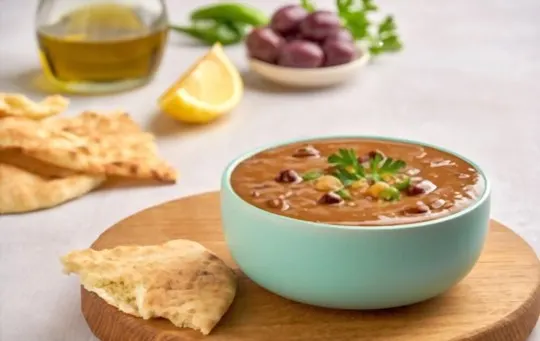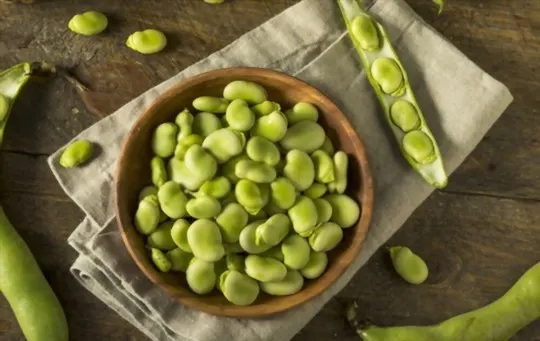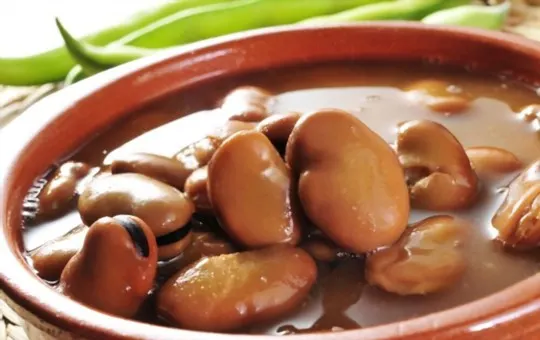Have you ever taken a bite of food and thought to yourself, “What do fava beans taste like?”
Fava beans are a peculiar-looking vegetable that’s been around for centuries, yet so few people actually know what they taste like.
Drawing from the collective knowledge of many chefs and experts in food science, weíve compiled an extensive guide on fava bean flavors and how to prepare them for your own culinary experience.
Whether youíre looking to explore recipes beyond the basics or refine your cooking techniques with newfound inspiration, this comprehensive guide will shed some light on this unique plant — Its unique flavor profile, its versatility as an ingredient in dishes across cultures, and which ingredients subtly enhance its flavor further.
Put simply: It is time to learn more about fava beans!
What are Fava Beans?

Fava beans are a type of legume that is native to the Mediterranean region.
They are also known as broad beans, and they have been cultivated for thousands of years.
Fava beans are grown in pods and have a distinctive flavor that sets them apart from other types of beans.
They are an excellent source of protein, fiber, vitamins, and minerals.
Fava beans come in different varieties and can be found in many grocery stores around the world.
They are a popular ingredient in many cuisines, including Italian, Spanish, Turkish, Egyptian, and Ethiopian dishes.
The beans themselves can be eaten either fresh or dried and have a firm texture that holds up well in stews, soups, salads, and dips.
Fresh fava beans need to be blanched before eating to remove their tough outer skin.
Dried fava beans require soaking overnight before being cooked by boiling or pressure cooking.
When cooked properly, fava beans have a tender texture with an earthy flavor that some people compare to nuts or peas.
Overall, fava beans are a nutritious food choice that offers a unique taste experience for those who enjoy exploring international cuisine.
In the next section of this article, we will take a closer look at the taste profile of fava beans and how they can be enjoyed in different recipes.
What Do Fava Beans Taste Like?

Fava beans, also known as broad beans, have a distinct earthy and slightly bitter taste.
They are often compared to lima beans or edamame, but with a more robust flavor profile.
When cooked properly, fava beans can have a creamy texture that pairs well with bold flavors like garlic and herbs.
They can also be pureed into a smooth dip or added to soups and stews.
One factor that affects the taste of fava beans is the maturity of the bean.
Younger beans will have a sweeter and milder flavor, while older beans will be more bitter.
It’s important to select fresh fava beans from the market as they can quickly become tough and mealy in texture.
Another factor is the cooking method used.
Fava beans require some preparation before consumption as they contain an outer shell that needs to be removed.
Boiling them for a few minutes and then plunging them into cold water before peeling can help remove the bitter taste.
Overall, the taste of fava beans can be polarizing due to its earthy and slightly bitter flavor profile.
However, when prepared correctly with complementary ingredients, it can make for a delicious dish that stands out on its own or complements other flavors well.
Factors That Affect the Taste of Fava Beans

The taste of fava beans is determined by several factors, including the variety of the bean, the age of the bean, and how it is cooked.
- The variety of fava bean has a significant impact on its taste. Different types of fava beans have varying levels of sweetness or bitterness, which results in different flavor profiles. For example, some varieties may have a nutty or buttery flavor, while others may be more herbaceous or earthy.
- The age of the fava bean also affects its taste. Fresh fava beans are sweet and tender, with a creamier texture. As they age, they become starchier and develop a stronger flavor that may be slightly bitter.
- How fava beans are cooked can also influence their taste. Overcooking them can cause them to become mushy and lose their natural sweetness. On the other hand, undercooked fava beans may remain tough and difficult to eat.
Finally, seasoning plays an essential role in enhancing the flavor profile of fava beans.
Adding salt or other spices like cumin or garlic can bring out their natural flavors and make them more palatable to most people.
In summary, the type of fava bean used, its age when cooked, cooking method adopted along with seasoning utilized all contribute together to produce unique tastes.
Culinary Uses of Fava Beans

Fava beans are a versatile ingredient that can be used in various cuisines around the world.
They can be consumed in both their raw and cooked form, and their flavor profile complements many other ingredients.
Overall, these are just some examples of how versatile fava beans can be in cooking.
Don’t hesitate to experiment with your own recipes using this nutritious ingredient.
Is Eating Fava Beans Healthy?
Eating fava beans can be a healthy addition to your diet.
They are low in fat and calories but high in protein, fiber, and various nutrients that provide essential health benefits.
Fava beans are also high in antioxidants such as polyphenols that help protect your body from damage caused by free radicals.
Apart from being a source of nutrition, fava beans have potential health benefits that may help reduce the risk of cancer, heart disease, and diabetes.
The high dietary fiber content plays a vital role in promoting digestive health, reducing inflammation, and controlling blood sugar levels.
However, it is recommended that individuals with G6PD deficiency should avoid consuming fava beans due to the risk of triggering hemolysis – a condition where red blood cells burst open.
Additionally, some people may develop an allergic reaction after consuming fava beans.
Therefore, if you experience symptoms such as skin rash or difficulty breathing after consuming fava beans, seek medical attention immediately.
Where to Buy Fava Beans and How to Store Them?

If you’re wondering where to buy fava beans and how to store them, we’ve got you covered.
Here are some tips to help you out:
- You can buy fresh fava beans when they’re in season at farmers’ markets or specialty grocery stores. Look for bright green pods that feel firm and smooth.
- If you can’t find fresh fava beans, you may be able to find dried ones at a health food store or online. They will need to be soaked overnight before cooking.
- To store fresh fava beans, remove them from the pods and blanch them in boiling water for a couple of minutes. Then transfer them to a bowl of ice water to cool down before draining and drying them. Once they’re dry, put them in an airtight container and store them in the fridge for up to five days.
- If you have leftover cooked fava beans, they will keep for up to three days in the fridge or several months in the freezer.
- Dried fava beans should be stored in an airtight container in a cool, dry place (like your pantry) for up to six months.
When it comes to buying and storing fava beans, it’s important to remember that they require some preparation before consuming.
However, their unique flavor and nutritional benefits make them worth the effort.
Fava bean season typically runs from late spring through early summer, so keep an eye out at your local farmers’ market during those months.
And with proper storage techniques, you can enjoy this delicious legume year-round.
Conclusion
When it comes to buying and storing fava beans, it’s essential to choose fresh ones that are free from any visible damage or mold.
You can find fava beans at most local grocery stores or farmers’ markets during the spring season.
Once you’ve bought them, store them in an airtight container in the refrigerator for up to five days.
Overall, adding fava beans to your diet is an excellent way to improve your overall health and well-being.
They are easy to incorporate into various meals and offer numerous health benefits that should not be overlooked.
So next time you come across these velvety pods don’t hesitate to give them a try.

What Do Fava Beans Taste Like? A Comprehensive Guide
Ingredients
- Fava beans
- Ingredients from your selected recipes
Instructions
- Select ingredients that work well together.
- Use a recipe or method that will enhance their natural taste.
- Taste and adjust the recipe as needed to achieve the desired flavor.

Carrie is a food writer and editor with more than 15 years of experience. She has worked for some of the biggest names in the food industry, including Bon Appétit, Food & Wine, and Martha Stewart Living.
As the Editor in Chief of IntroChicago.com, Carrie oversees all of the content on the site. She also manages the team of contributing writers and editors, who help to create delicious recipes, helpful tips, and informative articles that you’ll find on the site.
A native of the Chicago area, Carrie is passionate about all things food. She loves trying new restaurants and experimenting with new recipes in her kitchen. She’s also a graduate of the Culinary Institute of America, so she knows a thing or two about food!
